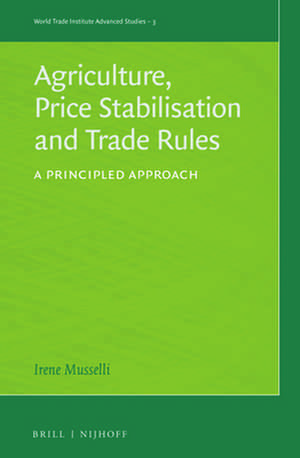Agriculture, Price Stabilisation and Trade Rules: A Principled Approach: World Trade Institute Advanced Studies, cartea 3
Autor Irene Mussellien Limba Engleză Hardback – 15 aug 2017
Preț: 816.06 lei
Preț vechi: 995.20 lei
-18% Nou
Puncte Express: 1224
Preț estimativ în valută:
156.15€ • 162.72$ • 129.29£
156.15€ • 162.72$ • 129.29£
Carte indisponibilă temporar
Doresc să fiu notificat când acest titlu va fi disponibil:
Se trimite...
Preluare comenzi: 021 569.72.76
Specificații
ISBN-13: 9789004314238
ISBN-10: 9004314237
Dimensiuni: 155 x 235 mm
Greutate: 0.64 kg
Editura: Brill
Colecția Brill | Nijhoff
Seria World Trade Institute Advanced Studies
ISBN-10: 9004314237
Dimensiuni: 155 x 235 mm
Greutate: 0.64 kg
Editura: Brill
Colecția Brill | Nijhoff
Seria World Trade Institute Advanced Studies
Notă biografică
Irene Musselli, Ph.D. (2016), University of Bern, is senior researcher at the Centre for Development and Environment (CDE) at the University of Bern. Before joining the CDE, she was programme officer at UNCTAD, where she worked extensively on strategies and policies to respond to the challenges of commodity markets, with a particular focus on agriculture.
Cuprins
Series Editor ForewordPrefaceList of Abbreviations1 Introduction1.1 Scoping the Research 1.2 Agricultural Price Stabilisation: Why Does it Matter 1.2.1The Inherent Volatility of Agricultural Commodity Prices1.2.2Socio-economic Costs of Agricultural Price Volatility in Poor Countries1.2.3The Need for Regulatory Responses1.3 Research Design and Method 1.3.1Research Outline1.3.2Interdisciplinary Aspects and Legal Approaches1.3.3Information Sources1.4 Shortfalls and Reach of this Inquiry2 Setting the Stage: Key Concepts and Issues 2.1 Agricultural Price Stabilisation: Unpacking the Notion 2.1.1Agricultural Commodities 2.1.2Agricultural Price Instability 2.1.3Assessment 2.2 Agricultural Price Stabilisation Arrangements: An Overview 2.2.1International Schemes 2.2.2Domestic Schemes 2.2.3Assessment 2.3 Agricultural Price Stabilisation and Trade Rules: Seizing the Interface 2.3.1The Regulatory Framework 2.3.2International Schemes 2.3.3Domestic Arrangements 2.3.4Assessment3 A Historical Review of Multilaterally Agreed Criteria for Action on Commodity Prices (1947–1989)3.1 A Descriptive Account: Havana, Geneva and Nairobi 3.1.1The Havana Charter Framework 3.1.2gatt Discussions (1954–1955 Review Session) 3.1.3unctad’s ipc (1964–1989) 3.2 Objectives and Principles of Multilateral Action on Commodity Prices 3.2.1A Textual and Contextual Reading 3.2.2State Practice and Attitudes 3.2.3Assessment 4 From Market Intervention to Free Trade and Back to Managed Trade? (1989–2011) 4.1 The Market-based Interlude (1989–2007) 4.1.1The ‘Neoliberal’ Agenda: Trade Policy Implications 4.1.2The Extent of Policy Reform in Commodities 4.1.3Which Orientation for the wto Agreement on Agriculture? 4.1.4Assessment 4.2 Towards Re-regulation? The 2007–08 and 2010–11 Commodity Crises 4.2.1Recent Price Developments in Commodity Markets 4.2.2Trade Rules and Commodity Prices: Trade Policy Trajectories 4.2.3Assessment 5 Beyond the Impasse: Towards a New Normative Approach 5.1 The Framework Outlined 5.1.1Conceptual Underpinnings and Legal Bases 5.1.2Normative Goals 5.1.3Operational Principles 5.2 Testing the Framework: A Reassessment of Key Trade Policy Issues in the Stabilisation Debate 5.2.1Public Food Purchases at Administered Prices 5.2.2Price Band Systems (pbs) 5.2.3Commodity Marketing Boards 5.2.4Export Restrictions 5.2.5Concerted Price Action 5.3 Implementation Avenues 5.3.1Litigation 5.3.2Law-making and Negotiations 5.3.3Assessment 6 Conclusion 6.1 Domestic Stabilisation Policies 6.2 Intergovernmental Commodity Control Agreements Appendix 1: Product Coverage, Agricultural ICAs Appendix 2: Ranking of Economies by Agricultural Export DependenceAppendix 3: Major Commodity Control Arrangements, by Product Appendix 4: CAP Developments: An Overview Appendix 5: US Farm Bills: A Snapshot BibliographyIndex













